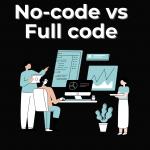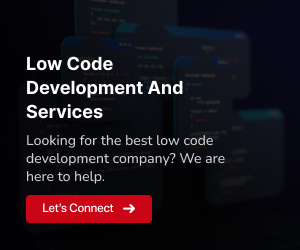In the dynamic realm of software development, the advent of Low Code, No Code, and Visual Development platforms has significantly altered the landscape. These innovative approaches have democratized the process of application creation, allowing businesses and individuals to bring their ideas to life without the exhaustive requirement of traditional coding. In this extensive exploration, we will delve deeply into Low Code, No Code, and Visual Development, comprehensively understanding their differences, applications, and profound impact on the world of technology.
Understanding Low Code, No Code, and Visual Development
1. Low-Code Development: Where Efficiency Meets Customization
Low-code platforms empower developers with a visually intuitive interface, reducing the reliance on extensive manual coding. These platforms, tailored for developers and IT professionals, offer a wide array of pre-built components and drag-and-drop functionalities, expediting the development lifecycle. Low-code tools are instrumental when projects demand a certain level of customization and complexity while focusing on accelerating the app delivery process.
Applications:
- Enterprise-grade software
- Customer Relationship Management (CRM) systems
- workflow automation solutions
- intricate business applications.
User Profile:
Developers with coding expertise, emphasizing efficiency, and tailored solutions.
Key Advantages:
- Rapid development
- enhanced flexibility
- seamless integration capabilities
- reduced overall development costs.
2. No-Code Development: Empowering Creativity Beyond Coding Barriers
No-code platforms take the simplicity of application creation to unprecedented heights, enabling individuals with no coding background to craft functional applications. These platforms leverage a purely visual drag-and-drop interface, allowing users to design applications intuitively. Tailored for business analysts, marketers, and entrepreneurs, no-code solutions facilitate swift prototyping, empowering users to iterate and deploy applications independently without delving into the intricacies of coding.
Applications:
- Basic applications
- online forms
- surveys
- simple workflow automation
- rapid prototype development.
User Profile:
Business professionals, entrepreneurs, and individuals without coding expertise emphasise user-friendliness and rapid prototyping.
Key Advantages:
- Swift prototyping
- user-friendly interfaces
- reduced dependency on IT departments
- cost-effective solution deployment
3. Visual Development: Striking the Perfect Balance Between Code and No-Code
Visual development platforms bridge the gap between traditional coding and no-code interfaces. These platforms offer a graphical environment for designing applications visually, coupled with the flexibility of intervening with custom code when necessary. Tailored for developers seeking a simplified yet dynamic interface and businesses requiring specialized applications, visual development tools provide a harmonious blend of customization and ease of use.
Applications:
- Interactive dashboards
- data visualization tools
- departmental applications
- projects demanding specific functionalities
User Profile:
Developers looking for simplified interfaces, businesses with unique application requirements, and those valuing balanced customization.
Key Advantages:
- Balanced customization options
- ease of use
- efficient collaboration between development teams and business stakeholders
- seamless integration capabilities
Impact on Digital Transformation and Innovation
1. Accelerating Digital Transformation: Streamlining Processes for Tomorrow
Low-code, no-code, and visual development platforms have emerged as catalysts for digital transformation initiatives. By expediting the development lifecycle, these platforms empower organizations to respond promptly to market demands and customer needs. Complex processes are simplified, enabling businesses to streamline operations, elevate customer experiences, and nurture a culture of innovation.
Impact:
Agile development methodologies, streamlined business processes, enhanced customer engagement strategies, and acceleration of innovation initiatives.
2. Fostering Innovation and Collaboration: Democratizing App Development
The democratization of application development is a hallmark of these methodologies. No-code solutions, in particular, empower employees from diverse departments to actively contribute to the development process. This inclusivity fosters a culture of innovation, enabling creative problem-solving and ideation. Collaboration between IT and business teams becomes seamless, leading to the creation of tailored solutions that precisely meet specific needs.
Impact:
Inclusive innovation initiatives, democratized app development processes, efficient cross-team collaboration, and creative problem-solving approaches.
Choosing the Right Approach: A Strategic Decision
Amidst the array of choices, selecting the most fitting approach for a particular project is pivotal. Factors such as project complexity, the technical expertise of the team, the level of customization required, scalability needs, security considerations, and integration capabilities play a crucial role in the decision-making process. A well-informed choice ensures that the selected platform aligns seamlessly with the project’s unique requirements.
Considerations:
Project complexity, technical expertise, customization needs, scalability requirements, security considerations, and integration capabilities.
Get in touch with us today and transform your ideas into reality! Our expert team is ready to assist you. Reach out now to kick-start your innovative projects!
Conclusion: Embracing the Future of Application Development
In conclusion, the paradigm shift ushered in by Low Code, No Code, and Visual Development methodologies signifies a new era in the realm of application development. Each approach offers a distinctive set of advantages, empowering businesses and individuals to innovate and transform concepts into functional applications. By comprehensively understanding the differences between Low Code, No Code, and Visual Development, organizations can harness the power of these platforms strategically. This strategic utilization fosters digital transformation, fuels innovation, and positions businesses at the forefront of the rapidly evolving technological landscape.
Embrace the future of application development with the right tools, tailored precisely to your unique needs and aspirations. Navigate the intricate maze of technology with confidence, creativity, and a profound understanding of these transformative methodologies.





















